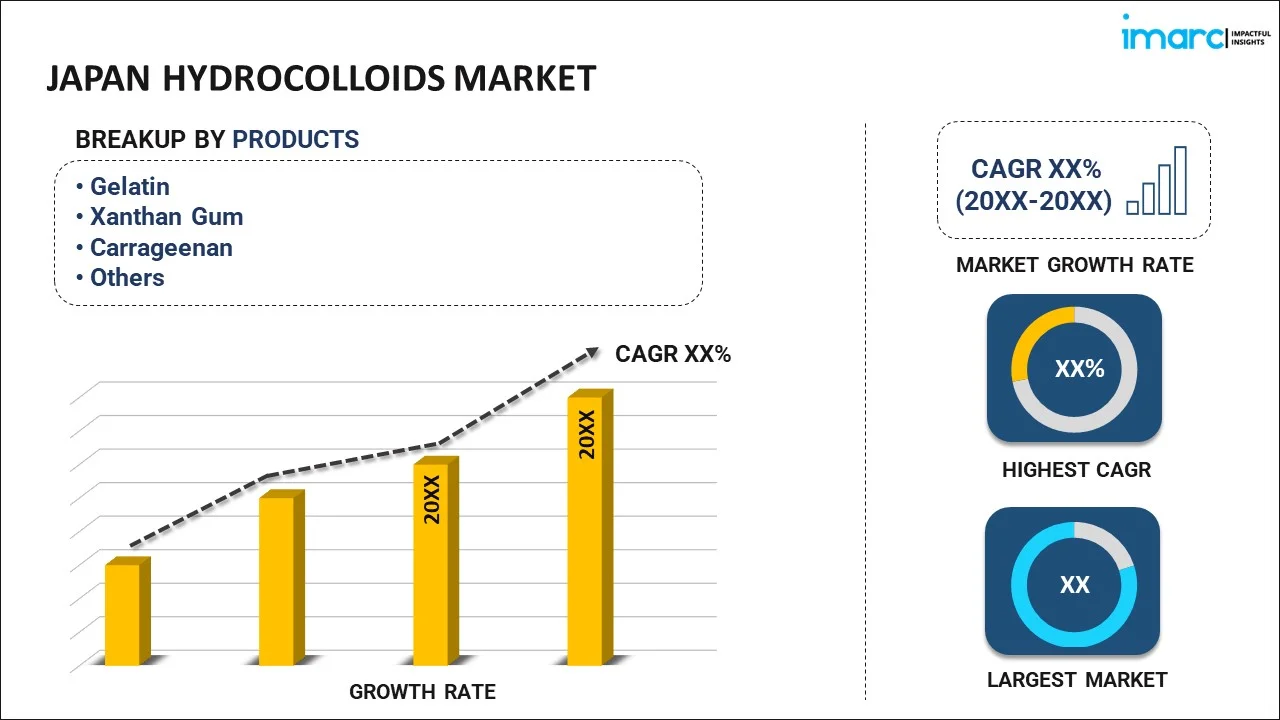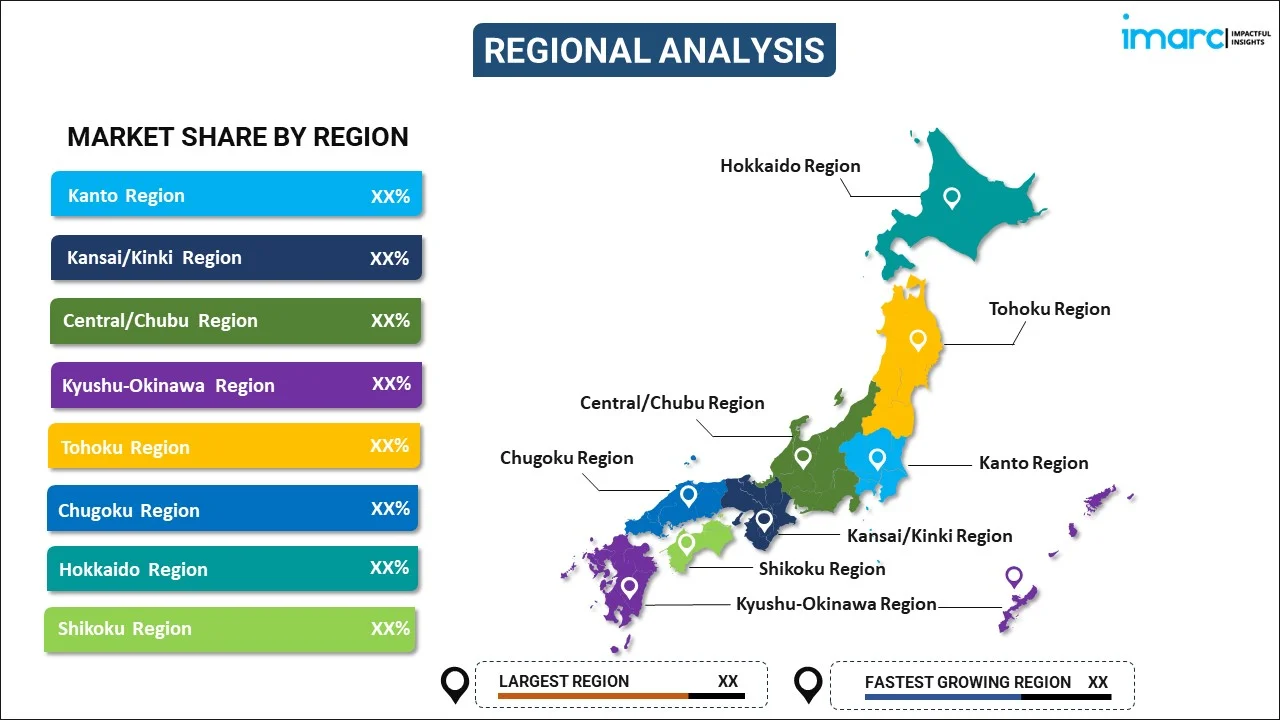
Japan Hydrocolloids Market Report by Product (Gelatin, Xanthan Gum, Carrageenan, Guar Gum, and Others), Source (Animal, Botanical, Microbial, Seaweed, Synthetic), Function (Thickening, Gelling, Stabilizing, and Others), Application (Food and Beverages, Personal Care and Cosmetics, Pharmaceuticals), and Region 2025-2033
Market Overview:
Japan hydrocolloids market size reached USD 739.3 Million in 2024. Looking forward, IMARC Group expects the market to reach USD 1,194.1 Million by 2033, exhibiting a growth rate (CAGR) of 5.5% during 2025-2033. The growing popularity of clean-label, plant-based, and organic food products, rising awareness about food allergies and dietary restrictions among the masses, and increasing focus on health and wellness represent some of the key factors driving the market.
|
Report Attribute
|
Key Statistics
|
|---|---|
|
Base Year
|
2024 |
|
Forecast Years
|
2025-2033
|
|
Historical Years
|
2019-2024
|
| Market Size in 2024 | USD 739.3 Million |
| Market Forecast in 2033 | USD 1,194.1 Million |
| Market Growth Rate (2025-2033) | 5.5% |
Hydrocolloids, often referred to as hydrophilic colloids, are substances that can disperse in water and form a gel-like structure, usually due to their ability to absorb and retain water. They comprise pectin, agar, and carrageenan, which are extracted from various plants and algae. They also consist of xanthan gum and gellan gum, which are produced through microbial fermentation. They include various animal-derived hydrocolloids like gelatin and synthetic hydrocolloids like carboxymethyl cellulose (CMC) and methylcellulose, which are used in various applications due to their consistency and stability. They stabilize suspensions, emulsions, and dispersions in many applications, preventing phase separation and sedimentation. They are employed to make hydrocolloid-based edible films, which can extend the shelf life of perishable foods by protecting them from moisture and oxygen. They can extend the shelf life of perishable foods by protecting them from moisture and oxygen. They can be used to control drug release, improving the effectiveness and safety of medications. They have the capacity to form gels, which can range from weak, thixotropic gels to strong, heat-set gels. They are used to adjust the texture and thickness of various products, ranging from salad dressings to pharmaceutical syrups. Hydrocolloids are employed in the textile industry for sizing, dyeing, and finishing operations.
Japan Hydrocolloids Market Trends:
At present, the increasing demand for natural hydrocolloids as individuals are becoming more health-conscious and seeking cleaner label products represents one of the crucial factors impelling the growth of the market in Japan. Besides this, the rising popularity of clean-label, plant-based, and organic food products is driving the demand for natural hydrocolloids, as these ingredients are known for their stabilizing, gelling, and thickening properties. In addition, the growing consumption of processed foods, ready-to-eat (RTE) meals, and convenience products, which rely heavily on hydrocolloids for texture, stability, and shelf-life extension, is offering a favorable market outlook in the country. Apart from this, the increasing awareness about food allergies and dietary restrictions is leading to the development of specialized hydrocolloid-based products, such as gluten-free and vegan options, for catering to a broader consumer base. Additionally, the increasing incorporation of hydrocolloids in dietary supplements, probiotics, and nutraceuticals, as they aid in encapsulating bioactive compounds and enhancing their bioavailability, is supporting the market growth. The pharmaceutical and personal care industries are also embracing hydrocolloids for their various applications, including wound care, drug delivery systems, and cosmetic products. Moreover, the increasing focus on health and wellness is strengthening the market growth in the region. Furthermore, the growing emphasis on eco-friendly and sustainable production methods is encouraging individuals and manufacturers to seek alternatives to traditional hydrocolloids derived from non-renewable resources.
Japan Hydrocolloids Market Segmentation:
IMARC Group provides an analysis of the key trends in each segment of the market, along with forecasts at the country level for 2025-2033. Our report has categorized the market based on product, source, function, and application.
Product Insights:

- Gelatin
- Xanthan Gum
- Carrageenan
- Guar Gum
- Others
The report has provided a detailed breakup and analysis of the market based on the product. This includes gelatin, xanthan gum, carrageenan, guar gum, and others.
Source Insights:
- Animal
- Botanical
- Microbial
- Seaweed
- Synthetic
A detailed breakup and analysis of the market based on the source have also been provided in the report. This includes animal, botanical, microbial, seaweed, and synthetic.
Function Insights:
- Thickening
- Gelling
- Stabilizing
- Others
The report has provided a detailed breakup and analysis of the market based on the function. This includes thickening, gelling, stabilizing, and others.
Application Insights:
- Food and Beverages
- Personal Care and Cosmetics
- Pharmaceuticals
A detailed breakup and analysis of the market based on the application have also been provided in the report. This includes food and beverages, personal care and cosmetics, and pharmaceuticals.
Regional Insights:

- Kanto Region
- Kansai/Kinki Region
- Central/ Chubu Region
- Kyushu-Okinawa Region
- Tohoku Region
- Chugoku Region
- Hokkaido Region
- Shikoku Region
The report has also provided a comprehensive analysis of all the major regional markets, which include Kanto Region, Kansai/Kinki Region, Central/ Chubu Region, Kyushu-Okinawa Region, Tohoku Region, Chugoku Region, Hokkaido Region, and Shikoku Region.
Competitive Landscape:
The market research report has also provided a comprehensive analysis of the competitive landscape in the market. Competitive analysis such as market structure, key player positioning, top winning strategies, competitive dashboard, and company evaluation quadrant has been covered in the report. Also, detailed profiles of all major companies have been provided. Some of the key players include:
- Cargill Incorporated
- CP Kelco U.S. Inc. (CP Kelco ApS)
- Ingredion Japan Co. Ltd.
- Nexira SAS
(Please note that this is only a partial list of the key players, and the complete list is provided in the report.)
Japan Hydrocolloids Market Report Coverage:
| Report Features | Details |
|---|---|
| Base Year of the Analysis | 2024 |
| Historical Period | 2019-2024 |
| Forecast Period | 2025-2033 |
| Units | Million USD |
| Scope of the Report | Exploration of Historical and Forecast Trends, Industry Catalysts and Challenges, Segment-Wise Historical and Predictive Market Assessment:
|
| Products Covered | Gelatin, Xanthan Gum, Carrageenan, Guar Gum, Others |
| Sources Covered | Animal, Botanical, Microbial, Seaweed, Synthetic |
| Functions Covered | Thickening, Gelling, Stabilizing, Others |
| Applications Covered | Food and Beverages, Personal Care and Cosmetics, Pharmaceuticals |
| Regions Covered | Kanto Region, Kansai/Kinki Region, Central/ Chubu Region, Kyushu-Okinawa Region, Tohoku Region, Chugoku Region, Hokkaido Region, Shikoku Region |
| Companies Covered | Cargill Incorporated, CP Kelco U.S. Inc. (CP Kelco ApS), Ingredion Japan Co. Ltd., Nexira SAS, etc |
| Customization Scope | 10% Free Customization |
| Post-Sale Analyst Support | 10-12 Weeks |
| Delivery Format | PDF and Excel through Email (We can also provide the editable version of the report in PPT/Word format on special request) |
Key Questions Answered in This Report:
- How has the Japan hydrocolloids market performed so far and how will it perform in the coming years?
- What has been the impact of COVID-19 on the Japan hydrocolloids market?
- What is the breakup of the Japan hydrocolloids market on the basis of product?
- What is the breakup of the Japan hydrocolloids market on the basis of source?
- What is the breakup of the Japan hydrocolloids market on the basis of function?
- What is the breakup of the Japan hydrocolloids market on the basis of application?
- What are the various stages in the value chain of the Japan hydrocolloids market?
- What are the key driving factors and challenges in the Japan hydrocolloids?
- What is the structure of the Japan hydrocolloids market and who are the key players?
- What is the degree of competition in the Japan hydrocolloids market?
Key Benefits for Stakeholders:
- IMARC’s industry report offers a comprehensive quantitative analysis of various market segments, historical and current market trends, market forecasts, and dynamics of the Japan hydrocolloids market from 2019-2033.
- The research report provides the latest information on the market drivers, challenges, and opportunities in the Japan hydrocolloids market.
- Porter's five forces analysis assist stakeholders in assessing the impact of new entrants, competitive rivalry, supplier power, buyer power, and the threat of substitution. It helps stakeholders to analyze the level of competition within the Japan hydrocolloids industry and its attractiveness.
- Competitive landscape allows stakeholders to understand their competitive environment and provides an insight into the current positions of key players in the market.
Need more help?
- Speak to our experienced analysts for insights on the current market scenarios.
- Include additional segments and countries to customize the report as per your requirement.
- Gain an unparalleled competitive advantage in your domain by understanding how to utilize the report and positively impacting your operations and revenue.
- For further assistance, please connect with our analysts.
 Inquire Before Buying
Inquire Before Buying
 Speak to an Analyst
Speak to an Analyst
 Request Brochure
Request Brochure
 Request Customization
Request Customization




.webp)




.webp)












